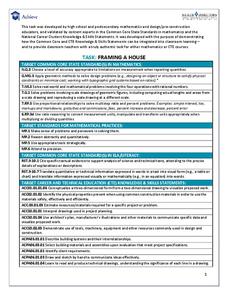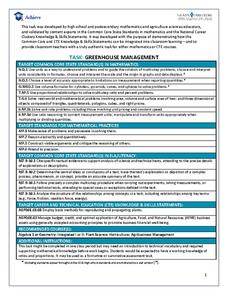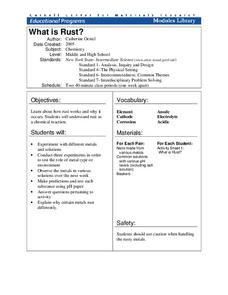Curated OER
Ordering Sets of Measures
This isn't an ordinary number sequencing activity; as scholars put these values in order they must pay close attention to the units attached. Each set of numbers has different units of measurement, so they must convert to order them from...
Illustrative Mathematics
Runners' World
Learners must investigate the validity of a claim made in a running magazine. They must identify and look up unprovided information, make appropriate estimations, and be able to convert units. Might be best used as a group or whole-class...
Illustrative Mathematics
Graphs of Quadratic Functions
The equations look different, but their graphs are the same. How can that be? This activity leads your mathematicians in an exploration of three different forms of the same quadratic function. After comparing the equations, their graphs,...
Illustrative Mathematics
Writing Constraints
Use this resource to present your number crunchers with how to write a constraint equation and to determine viable solutions. The price of an object limits the amount that can be purchased. The speed at which you walk limits the number...
Curated OER
Bernardo and Sylvia Play a Game
This activity presents a game played by two learners whose solution is an exercise in creating and analyzing with algebraic inequalities.
Mathed Up!
Fractions of an Amount
After viewing a video on fractional amounts, young mathematicians put their new knowledge to the test. Throughout the assessment, class members find the fractional amount for prices, times, and populations. There are a few percent and...
Mathed Up!
Metric and Imperial Measures
After watching a brief video on making metric conversions to standard units, pupils complete tables to describe certain items with the appropriate unit of measurement. Then, they convert liters to millimeters, millimeters to...
Achieve
Framing a House
If members of your class wonder where they can use the math they learn in middle school, let them discover the answer. Learners apply geometry concepts of scale and measure to calculate the costs of framing a house addition.
Achieve
Greenhouse Management
Who knew running a greenhouse required so much math? Amaze future mathematicians and farmers with the amount of unit conversions, ratio and proportional reasoning, and geometric applications involved by having them complete the...
University of Georgia
The Power of Peanuts
Measure the amount of energy in a peanut by igniting a chemical reaction. Classes use a laboratory setup to burn a peanut and measure the amount of heat it releases through a temperature analysis. They calculate the number of Joules of...
Illustrative Mathematics
Temperature Conversions
Complete two conversions at once using compositions. Pupils use the conversion formulas for temperatures to calculate a formula to convert directly between Kelvin and Fahrenheit. Classmates determine the meanings of composition...
Cornell University
What Is Rust?
Why do metals rust differently? Scholars experiment with metal combinations in a hands-on activity. They create unique environments with different metals and compare the rate and amount of rust for each.
Physics Classroom
Vector Direction
Scholars practice vector direction notation in multiple formats. After mastering each individually, they work to convert from one to another as one part in a series of lessons on vectors and projectiles.
Curated OER
Photosynthesis
Learners conduct experiments with plants. In this photosynthesis activity, students examine plants under different types of lights. They calculate the amount of dissolved ocygen concentration and compare it to the formula for...
Curated OER
Are You Thirsty?
In this measurement worksheet, students read a table of products sold in a vending machine and their metric capacities. Students solve 6 word problems where they convert milliliters to liters and liters to milliliters. ...
Curated OER
WNBA Standings
In this decimals worksheet, students fill out a chart with scores from the Women's National Basketball Association. Students convert fractions to percents and decimals.
Curated OER
Logarithmic Form to Exponential Form and the Reverse
In this algebra worksheet, young scholars convert equations from logarithmic form to exponential form and do the reverse conversion. There are ten questions.
Curated OER
World War II - The Allied Response
Your class will benefit from this excellent presentation on World War II, and the Allied Response to Hitler's threat. The PowerPoint is packed with important information about battles, key figures in the war, and has an excellent...
Curated OER
Active and Passive Voice
How are the active and passive voices different, and when should you use each one? The first page of this two-page worksheet contains the rules and several examples. On the second page, your grammarians will be able to put pen to paper...
Inside Mathematics
Quadratic (2009)
Functions require an input in order to get an output, which explains why the answer always has at least two parts. After only three multi-part questions, the teacher can analyze pupils' strengths and weaknesses when it comes to...
University of Southern California
Mastering Microbes
Small but mighty! Learners explore the role of microbes in a healthy ecosystem. An engaging activity asks pupils to design an aquaponics system that demonstrates that healthy microbes are necessary to maintain the ecosystem.
Illustrative Mathematics
Comparing Years
Who knew that the Egyptian, Julian, and Gregorian year were different lengths? Your mathematicians will! They will have to calculate the difference between the years in seconds and find the percent change. Using dimensional analysis,...
Curated OER
Math Lesson: Just How Many is a "Million Dead"?
Learners are able to convert large numbers into meaningful ratios. They are able to conceptualize 1 million. Students grapple with the concept of a million. They use this activity to convey the idea of millions by converting war death...
Curated OER
Building a Ship Lesson Plan
Pupils draw a ship to scale, and calculate the real life size. They show that measurements on the drawingsare annotated with the distances reported in inches (fractions and decimals), and their real-world equivalents























